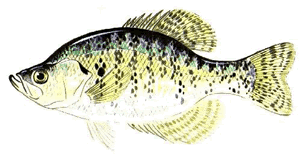Back to Previous Page
WHITE CRAPPIE

At-a-Glance
- Scientific Name: Pomoxis annularis
- Found in Illinois: Statewide
- State Average: 9"
- State Record: 4 lbs/7 oz (1973)
- Best Lures: minnows, jigs, spinners
Crappie strike a variety of baits and lures, however, fishing with live minnows is the most common. The best lure selection would be a jig that imitates a small minnow.
Crappies have a soft, fleshy mouth, and they are frequently referred to as "papermouths." Anglers need to be careful when setting the hook and handling crappie. Too much play or force during retrieval will tear the mouth and can result in losing the fish.
Most any type of fishing equipment can be used for crappie. It may be as simple as a cane pole or an ultra-light spinning or casting outfit. Lighter is better with crappie so anglers can detect a light or short strike. Monofilament line under 6 pound-test should be used.
Habitat: In Illinois, white crappie can be found statewide, most commonly in ponds, lakes, and bayous. Unlike the black crappie, the white crappie is more tolerant to turbid waters, where they tend to outnumber black crappie. As such, white crappie can also be found in sand- and mud-bottomed pools or backwaters of creeks.
Feeding and Habits: White crappie diets consist mostly of smaller fish (e.g., minnows), but will also feed on aquatic insects larvae, worms, and crustaceans.
Reproduction: White Crappie spawning takes place in late April and May when water temperature reaches about 56°F. The male fans out a depression with his caudal fin in 3 -10 feet of water. Female white crappie enter the spawning area and deposit their eggs in one or more of the nests, which are immediately fertilized by the male fish. The number of eggs in a crappie nest is variable, but a nest can hold up to 20,000. It is practically impossible to distinguish the males from the females, even just before spawning.



